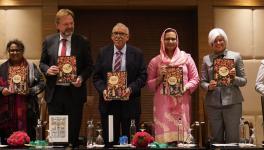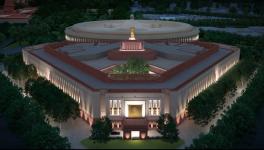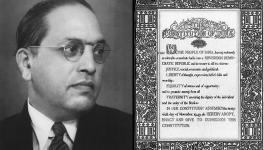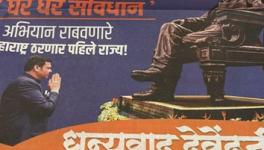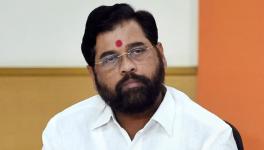Constitution or Anarchy - Do or Die for Nepali polity
Left intellectual Baburam Bhattarai's ascension to the post of PM in Nepal renews hopes for the completion of the Constitution writing process.
The Nepali polity united in the republican cause against the monarchy. They have to unite again for a Constitutional cause against anarchy.
Why does the new government led by Baburam Bhattarai engender so much hopes as compared to his predecessors? Firstly, Bhattarai, a well regarded left intellectual, is widely seen as the architect of the ideological turn among the Maoists which saw them enter the peace process by aligning with the mainstream polity against the monarchy and paved the way for the setting up of a secular republic in Nepal. Even before the peace process had commenced, Bhattarai had paved the way for reconciliation by identifying the monarchy in Nepali society and as the fountainhead of the “feudal system” that still held in sway. He argued that it required an alliance with the other political parties representing the parliamentary system, but which included among themselves, various progressives, democrats, and republicans to take on the monarchy and overcome the institution.
Secondly, Bhattarai has remained consistent in his insistence on the completion of the constitution writing process, as opposed to some of his other colleagues within the Maoists who have at times, betrayed impatience with the process or have taken inconsistent stances. We shall elaborate these issues in detail later, but suffice to say, Bhattarai’s recognition that the peace process will continue to be imperilled if the Maoists did not deal directly with the Nepali Congress, is the key to ending the various issues that plague the Constitution writing processes as well. Therefore it is significant that one of the immediate and first steps taken by the Bhattarai led government was to hand over keys of containers holding arms and ammunition in the Maoist Peoples Liberation Army cantonments to a joint Army Integration Special Committee of all party representatives empowered to work a rehabilitation/integration processes for ex-Maoist combatants into the Nepali Army.
Constituent Assembly Elections
It has been three years since the establishment of a constitutional republic in Nepal following a historic Constituent Assembly elections. These elections conducted as a mixture of a part proportional representation and part First Past the Post system yielded a result which to many analysts’ surprise established the Unified Communist Party of Nepal (Maoist) as the single largest party followed by the Nepali Congress and the Communist Party of Nepal (Unified Marxist-Leninist) and the Madhesi Peoples Forum.
The election results established that the parties favouring the immediate abolition of monarchy had been voted to power in a thumping majority. True to form, monarchy was immediately abolished at the first convening of the CA and Nepal had become a Constitutional republic. Nepal had the fortune of having the first elected Constituent Assembly in Asia. However, the bonhomie during this hour failed to last much longer. It was expected that the major political parties in Nepal would shepherd the process of writing a Constitution through discussion and debate in the CA, while they would form a national consensus government in the meantime to govern the nation.
Lack of consensus has been a serial issue since the convening of the CA. Four prime ministers have been elected in the past 3 years, 2 from the Maoists and 2 from the third placed UML. While the previous iterations of the government have failed to deliver a successful culmination of the peace process that was started in 2005 between the major parties or provide a stable government that lent constitution writing process a smooth pathway, it is widely hoped that the newly elected prime minister Baburam Bhattarai will pull a rabbit out of the hat in achieving the twin goals of “peace and constitution” by the stipulated deadline.
That seems a daunting task, considering that the deadline for the constitution writing has now been extended four times with some outstanding issues yet to be fully thrashed out by the various political actors in the CA. Chief among them include the issue of the nature of “federalism” that would determine political Nepal’s structure and the form of governance - a presidential system or a prime ministerial Parliamentary system? Clarity has yet to emerge about a meeting point between the main political parties about these issues, although the Maoists in particular have a clear stance on these matters, which is not to the complete acceptance of the other political parties.
Outstanding issues in the Peace Process
Rehabilitation/Integration of PLA combatants into the Nepali Army has been a festering issue that has acted as a stumbling block to national consensus. While the Nepali Congress, the UML and sections of the Madhesis have resented the presence of an armed setup for a political outfit - the Maoists, the latter argue that the PLA was treated at par with the Nepali Army when a peace accord was signed between the Maoists and a seven party alliance heralding the peace process.
Suspicions of Maoists’ intentions have hampered relations between the parties and some interventionist moves by the Indian embassy in political matters in Nepal have certainly not helped matters. This is another issue which we shall detail and discuss later, but it suffices to say now that the integration of Maoist combatants into the Nepali army is an issue that has strong dissident voices across the polity who have grudgingly accepted though, that this has to move forward in order to save the peace process.
After months of sporadic negotiations, this much is clear. There is tentative agreement on the need for rehabilitation and integration. Maoists have also accepted that unit-wise integration into the Nepali army is not going to be possible and that PLA cadre have to be retrained before their integration into the army apparatus through grouping and deployment in certain sphere such as industrial protection, national parks, security, etc. There is no agreement on the numbers; though the difference in respective calculations have considerably narrowed. We find that the Maoists seem to have quoted a number of around 7000 while the Nepal Congress seems to have privately accepted a figure of about 5-6000; numbers which certainly can be bridged.
The Maoists have tactfully handled the integration process over the years, holding their cards quite close to their chests for sometime. One can argue that they have ensured that the integration/rehabilitation process could take place only in favourable circumstances - that is with Maoist leadership in government and a stronger bargaining position. Over time, the other political parties have dropped their resistance to the “integration” of Maoist combatants, partly due to opportunism of various factions among these parties and partly due to a desire to continue the peace process. All said, it has meant that things are propitious for the disentanglement of the rehabilitation/ integration process.
Other issues pertain to justice for victims of the decade long “peoples’ war” involving the Maoists and the Nepali security forces. While the Maoists have asked for a general amnesty principle, it would be better if they could supplement it with their sincerity towards some form of reparations for victims of the war. This should be possible considering that their own senior leader is now the prime minister and who has pledged that “peace and a forward looking constitution” are his key priorities.
Other Constitutional Issues
The term, “forward looking” Constitution as one of the priorities of the prime minister lends weight to the fact that the Maoists are willing to be consensual about various issues that could determine the contours of the constitution but which also feature a lot of difference of views among the various political actors.
Chief among them is the issue of federalism. While the Maoists have proposed a strong -centre, autonomous state model - which is unique in one sense, other parties except for the Madhesis are not quite keen on creation of linguistically determined states. While the Madhesi parties - the newly formed United Democratic Madhesi Morcha - have insisted on a separate Madhes state, the other mainstream parties - the UML and NC have generally been reluctant on the issue of “federalism” except for stray progressive voices from within the parties. In fact, the current Maoist-Morcha alliance has been conceived primarily because of the closeness of understanding on the “state restructuring” issue.
The issue of “state restructuring” is considered a crucial one in the Constitution framing process. The idea of federalisation had simultaneously along with the peace process, created a new social upsurge of various marginalised identities in the country. This upsurge has tended more toward being a form of severe unrest especially in the Terai where groups such as the Limbus and the Tharus have come up with their own grievances and have not accepted a single Madhes state for example. Years of pent up anger over what has been termed “pahadi” domination has opened up demands for recognition and accommodation within the structures of power and federalism in the form of “state restructuring” is a key issue. If unaddressed this could accelerate processes of unrest even further.
Keys for a political consensus and the Endgame for the Constitution writing process
Having established the key areas which have to be addressed by the political parties for the successful culmination of the peace and constitution writing processes, we shall now examine the political constraints among the various parties that could possibly hamper the processes.
Among the Maoists, the internal debate about the steps taken in the near past by the party and its overall vision has only intensified in the recent years. A dogmatic and ideologically hardline section led by Mohan Baidya has generally denounced efforts by the other leaders, party chairman Prachanda and current prime minister Baburam Bhattarai to position their party as a player in a constitutional republic that allows for democratic spaces to other political parties in the system. The 2005 Chungwang plenum had established the political line calling for an end to the “People’s War” phase and preparing to negotiate peace with the parliamentary parties in order to set up a constitutional republic. The Baidya faction has disagreed with that “line” and had asked the party to prepare for a revolt that could lead to the setting up of a People’s Republic.
Intense debates between basically three factions - one led by Chairman Prachanda, the others by Baidya and Bhattarai respectively resulted in the coming together of the latter as a bloc to force the chairman Prachanda to concede various leadership powers to the other factions. This coming together of Baidya and Bhattarai also brought about an understanding on the need to complete the peace process and to write the Constitution despite reservations evinced by the former. But ideological issues remain unresolved as the Maoists still have not had a general congress to address them in full detail. While the Chungwang plenum had established that the Maoists have learnt from the mistakes made by other left wing communist guerilla movements elsewhere and are committed to “21st century socialism” which would feature democracy, it is evident that this declaration still has strong dissident voices from within.
An open debate and discussion among the Maoists that does not limit itself to resulting in expedient compromises and decisions is a need of the hour. While the Bhattarai faction believes that delivering the Constitution will win over support from the people who had voted specifically in that direction and will allow for the power and legitimacy to institute radical socio-economic reforms in the state, the Baidya faction still argues for capturing the state apparatus as a requisite for enacting ways to implement their party’s programme. The latter is also sceptical that a progressive Constitution can be wrought out through concessions to the right wing Nepali Congress. Prachanda’s faction has propounded a vaguely centrist position trying to reconcile both these lines, but that seems more to be a case of equivocation rather than steps for moving forward with an agenda.
Thus far, the Maoists have come a long way from a reclusive force suspected of winning support for itself through force and intimidation to becoming a mass movement that has triggered a social upsurge in a conservative and monarchic nation and leading its transformation into a constitutional republic. But the transformation of the Maoists has not been without fits and starts. There are still complaints about tactics of intimidation and force being used by Maoist cadre and middle rung leadership and Maoist intransigence about justice for criminal activities by some of their members.
Suffice to say, the Maoists’ ability to lead the peace and Constitution writing process to its completion will be yet another litmus test for its evolution. In that regard, Baburam Bhattarai’s ideas about developing consensus based on immediate issues such as “peace and constitution” have proven to be relevant for this test of the Maoists.
The demise of the Jhalanath Khanal led government and its inability to forge ahead with meaningful steps for Constitution writing or the peace process added a fillip to the process leading to the Maoists’ rallying around to Bhattarai’s views, which were expressed even as the Khanal government was being formed on the basis of a backroom deal between the Maoist chairman and the UML faction led by Khanal.
Bhattarai has insisted that a successful culmination of the peace process is possible only if the Maoists show greater sincerity in the integration process, build bridges with the premier opposition, the Nepali Congress by addressing concerns of the progressive sections within the latter apart from continuing to engage in political terms with the more ideologically closer but very disparate UML. Not to mention, winning over support from the Madhesis by remaining steadfast on the issue of state restructuring and recognition of the concerns of marginalised identities. In many ways, this is a true reflection of the views of the people in the 2008 elections as seen in the nature of the electoral mandate and the numbers - percentages of votes received by the various parties.
This approach offers a vista in the vexing process of building consensus. Bhattarai’s moves immediately after assuming power seem to be encouraging and in the right direction, but there are minefields aplenty, both from within his party as well as in Nepal’s mainstream polity.
Another significant aspect in the peace and constitution building process that needs to be mentioned is the role of the Indian embassy. This role is widely seen to be a case of “micro-managing” various political outfits in the country in order to isolate the Maoists, particularly in the aftermath of the fall of the Prachanda led government. These moves by the Indian diplomatic representatives in Nepal and supposedly orchestrated by sections of the Ministry of External Affairs in New Delhi have been deeply deleterious for the post-CA Nepal.
A separate discussion would be required for the role India has played and the changing courses of Indian foreign policy vis-a-vis Nepal, besides other issues related to geopolitical intrigue concerning the role that China is playing in Nepal today. Hopefully, the new ambassador to Nepal, Jayant Prasad replacing the highly unpopular Rakesh Sood, would provide a new model of engagement with Nepal that does not replicate the decisions of the predecessor.
This writer had visited Nepal just after the CA elections and had identified the lack of consensus, political intrigue, peoples’ high expectations as major challenges apart from the bottleneck being the rehabilitation/integration process and the issues of federalism. These were published in a series of articles in the Economic and Political Weekly. Coincidentally these views were expressed by a number of political actors not the least, the current PM himself.
Finishing the Constitution
Three years of political intrigue in Kathmandu has not whittled down the challenges and progress has been abysmally slow. In the meantime, Nepal’s economy has not improved - it is still dependent very highly on the remittance model, with a large number of its citizens migrating for better pastures. Relations between labour and business remains at the lowest ebb and public confidence in the political class has nearly bottomed out. There is no threat for a return to monarchy, as has been claimed by some cynical circles, but the dissatisfaction with the political class does not augur well.
Finishing the Constitution writing process is a must, as any other alternative - the CA being unable to finalise a constitution is ripe for an anarchic situation - that cannot be afforded by any rational thinking Nepali politician. The burden of preventing such a culmination now rests on the Maoists, who have to a play a game of balance and progress - with numerous adversaries from within and without. The simple realisation that it is a game that has to be won - for the sake of the Nepali public- therefore must make various actors in the Nepali polity as well as the Indian establishment take the right steps. This is not impossible as the events of 2005 showed when these very sections - the Maoists, the Nepali Congress, the UML and other parties managed to articulate an understanding against the common enemy of the very present monarchy and the peace process was brokered by the Indians as well. Today they have to do the same - against the common enemy of the possible anarchy that is bound to happen if a Constitution is not written.
Get the latest reports & analysis with people's perspective on Protests, movements & deep analytical videos, discussions of the current affairs in your Telegram app. Subscribe to NewsClick's Telegram channel & get Real-Time updates on stories, as they get published on our website.









